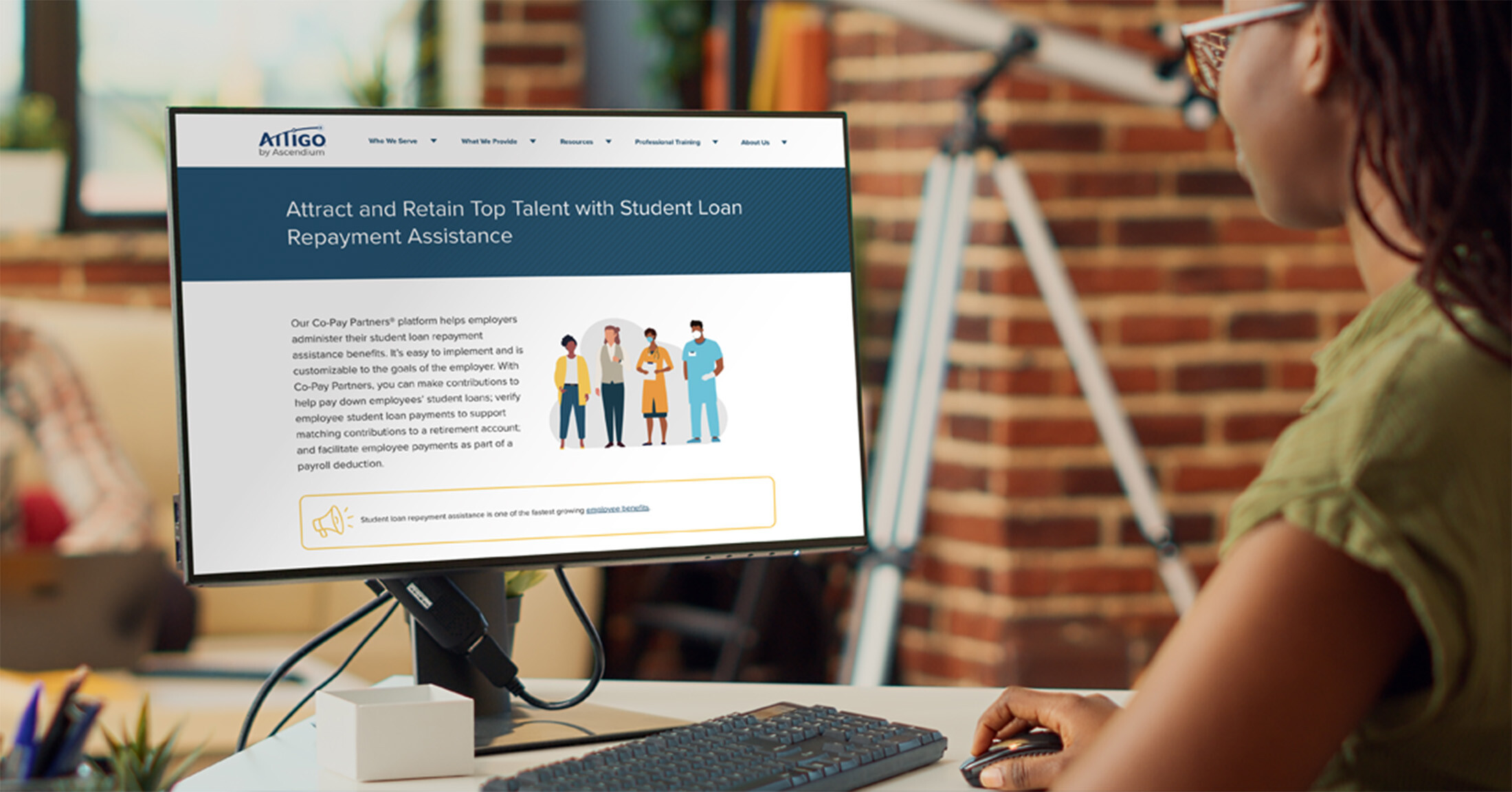A Deep Dive Into Student Loan Repayment Assistance

Student loan repayment assistance is one of the fastest growing non-health employee benefits. It addresses the burden that student loan debt places on today’s workforce and helps employers compete for top talent while saving on recruitment and retention costs. Student loan repayment assistance allows employers to make contributions toward an employee’s student loans or retirement account, reduce their financial stress, and improve workplace productivity and affinity.
Let’s take a look at the basics of student loan repayment assistance as well as some of the most recent data and most compelling reasons why adding a student loan repayment assistance perk to your benefits package is as important as ever.
Why is student loan repayment assistance one of the fastest growing non-health benefits?
The average college student now graduates with $37,088 in student loan debt, and collective federal student loan debt now exceeds $1.7 trillion (Source: educationdata.org). Given that there are 43.6 million student loan borrowers among the country’s 129 million privately employed workers, that means at least 1 in 4 of your employees carries the burden of student loan debt (Source: adpri.org).
Since the onset of the COVID-19 health crisis, the concept of work-life balance has changed dramatically and the dynamic between employees and employers has shifted. Moreover, younger generations are entering the workforce with higher expectations for employer support in all aspects of their lives. Workers are feeling more stress than ever before, but also more empowered. In fact, 46% of surveyed professionals say they are considering leaving their jobs in the next year, an even higher number than the Great Resignation of 2021 (Source: news.microsoft.com). These conditions are fueling a renewed focus on the “Whole Employee” model of holistic wellness programs and supplemental benefits, like student loan repayment assistance. That makes now the perfect time to create a program that supports employees and job seekers who still have debt and are concerned with balancing their budget.
Why is student loan repayment assistance beneficial to employers?
The key to attracting and keeping the best employees is to address the concerns that other employers don’t — peace of mind through student loan repayment assistance.
- It's a win-win for employers seeking to build and maintain the highest quality team, and a stress-relieving perk for employees who have student loan debt.
- Offering student loan repayment assistance means employers can compete for and retain a quality workforce and improve productivity and engagement levels.
- 55% of job seekers turned down a job at least one to three times due to dissatisfaction with benefits.
- 88% say they would increase their commitment to their employer if offered student loan repayment assistance.
- Employees will feel less financial stress, more easily reach financial goals, and be able to save for retirement.
- Payments, up to $5,250 annually, are tax-free within the context of an Educational Assistance Program (EAP), meaning they do not qualify as taxable income to the employee nor as a taxable expenditure to the employer.
- After months of rapid wage growth, salaries are stabilizing and attention is shifting from attracting talent to retaining it. Employee benefits are becoming a key focal point for differentiation.
- Many in the workforce carry higher-than-average debt loads, especially those with advanced degrees. In this competitive job market, employers can’t afford to lose top talent, since it may take months to fill a lost position.
Average Debt
- Bachelor’s degree: $33,448
- Master’s degree: $80,494
- Law school: $180,000
- Medical school: $200,00+
How many employers are offering this kind of program?
Although student loan repayment benefits are in demand, student loan repayment assistance is offered by just 9% of U.S. organizations according to the Society of Human Resource Management 2023 Benefits Survey (Source: shrm.org). In this competitive job market, that means employers who offer student loan repayment benefits have a better chance of tipping the scales in their favor when it comes to attracting top talent.
How do I know if implementing a student loan repayment assistance benefit will help my company save money and reduce turnover?
If the fact that 45% of workers consider student loan repayment assistance the single most important employee benefit isn’t enough to convince you, we’ve got you covered (Source: nasdaq.com). Attigo offers a free Student Loan Repayment Assistance ROI Calculator that can help you determine turnover cost with and without student loan repayment assistance, total student loan repayment assistance contribution and fees and turnover reduction.
Additionally, when it comes to student loan repayment assistance, the question isn’t if you can afford to offer it — it’s whether you can afford not to. Student loan repayment assistance easily pays for itself when you calculate that losing an employee costs 1.5-2 times their salary due to decreased team productivity, recruitment costs, new employee training and hidden costs like reduced morale.
Are employer-made student loan payments tax-free?
According to the Internal Revenue Code Requirements in Section 127, employer-made contributions to student loans are income tax-free for the employee and payroll tax-free for the employer through, at least, Dec. 31, 2025, and must be provided as part of an Educational Assistance Program (Source: uscode.house.gov).
What is a Qualified Education Loan for this purpose?
Both private and federal education loans obtained to pay for specific higher education expenses — including tuition, fees, room and board, books, supplies and other necessary expenses — are covered.
How do employers take advantage of this law?
Sec. 127 requirements include:
- The program must be a separate written plan of the employer for the exclusive benefit of its employees to provide such employees with educational assistance. Notably, Section 2206 of the CARES Act, which amended the IRS Code to make the benefit tax free, does not provide an exception to this rule, so employers might consider adopting a written educational assistance plan or amending their existing written educational assistance plan to incorporate this student loan payment benefit before taking advantage of Section 2206.
- The program must benefit employees who qualify under a classification set up by the employer that is not discriminatory in favor of highly compensated employees.
- No more than 5% of amounts paid by the employer for educational assistance during the year can be provided for individuals who own more than 5% of the stock or capital profits interest in the employer.
- The program cannot provide eligible employees with a choice between educational assistance and other remuneration included in gross income.
- Reasonable notification of the availability and terms of the program must be provided to eligible employees.
If your company doesn’t have an EAP, organizations like SHRM can provide guidance and resources to help you design and manage an educational assistance program.
When you're ready to introduce student loan repayment assistance to your employees, we encourage you to find a comprehensive solution to help you reap the rewards of adding this program to your arsenal of benefits.
How does student loan repayment assistance impact borrowers in an Income Driven Repayment Program?
Student loan borrowers who are using an Income Driven Repayment (IDR) plan are subject to an annual evaluation of their Adjusted Gross Income (AGI) per their federal tax return. IDR payment options (e.g., SAVE and IBR) establish a monthly payment that is a percentage of the borrower’s discretionary income. If the employer’s payment is part of an eligible education assistance program and is not taxable, then it will not be included in the AGI and not impact the borrower’s monthly payment.
IDR plans enable borrowers to make monthly payments based on their income and family size, often resulting in lower monthly payments (Source: studentaid.gov). IDR borrowers are also eligible to have their remaining loan balances forgiven after 10 to 25 years of payments. Employees who take advantage of IDR repayment plan options can reduce their overall student loan obligation while maximizing the impact of employer contributions. Learn how personalized one-to-one counseling can help your employees find the repayment plan that works best for their unique situation.
What impact would student loan repayment assistance have on borrowers who are pursuing Public Service Loan Forgiveness?
People pursuing PSLF must meet specific criteria. They must make 120 qualifying monthly payments while working full-time (at least 30 hours per week) for a qualifying employer. Most qualifying PSLF repayment plans are based on income.
Even though PSLF-eligible employees are working towards student loan forgiveness, they must continue to make payments until they qualify. Providing student loan counseling and support alongside student loan repayment assistance lightens the burden of financial stress for your employees now while ensuring they have all the information they need to successfully navigate repayment into the future.
How does the SECURE Act 2.0 tie into student loan repayment assistance?
The SECURE Act 2.0 legislation provides opportunities for employees to pay off student debt and save for retirement by allowing their employer to contribute to their retirement account in the amount they are paying towards their student loans. This means employers can take advantage of student loan repayment assistance to help employees tackle their student loan payments today without sacrificing retirement contributions that will help with their future.
As one of the fastest growing non-health benefits, student loan repayment assistance is a win-win way for employers to stand out in a competitive job market. Download our free Employer’s Guide to Student Loan Repayment Assistance to learn about student loan paydown and easily create a student loan repayment benefit program of your own.
This blog is for educational purposes and to provide general information about the EAP opportunity and student loan repayment assistance. It is not a substitute for individualized advice from a qualified legal, tax or human resources practitioner.



